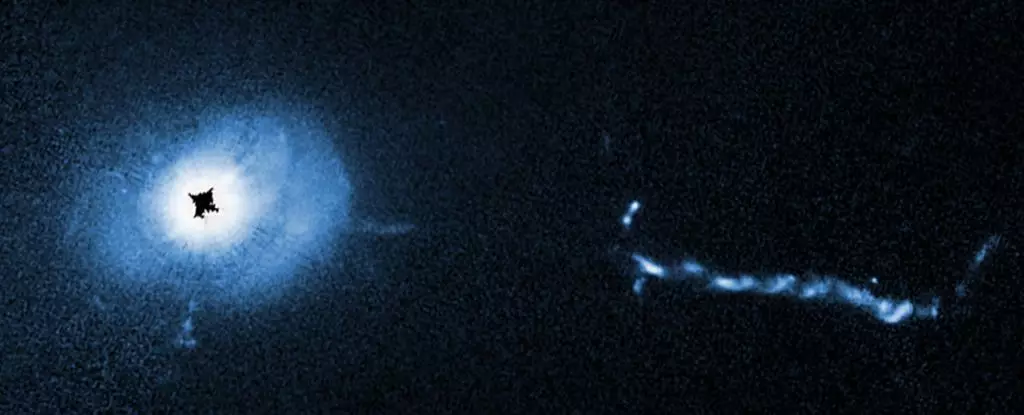Quasars represent one of the universe’s most intriguing phenomena, serving as cosmic beacons that illuminate vast stretches of space. Among them, 3C 273 stands out, not merely for its proximity to Earth—approximately 2.5 billion light-years away—but also for its extraordinary brightness. Recent observations from the Hubble Space Telescope have shed light on this quasar in ways that were previously unimaginable, opening new avenues for understanding the mechanisms that govern these celestial giants.
Quasars are fundamentally powered by supermassive black holes residing in the centers of distant galaxies. These black holes themselves are dark and undetectable; however, the material—gas and dust—that spirals into them emits tremendous amounts of energy. As this accreting material forms a swirling disk around the black hole, intense gravitational forces and friction heat it to extreme temperatures, producing brilliant light detectable across the electromagnetic spectrum. Therefore, quasars become the brightest objects in the universe, rivalled only by gamma-ray bursts and supernovae.
3C 273, while not the closest quasar to Earth, is unparalleled in brightness, shining with the luminosity equivalent to trillions of suns. Its brilliance is so pronounced that it remains observable through amateur telescopes from our own backyards. This makes 3C 273 an ideal candidate for detailed study, allowing astronomers to untangle the complexities of quasar phenomena.
The recent Hubble measurements utilized the Space Telescope Imaging System (STIS) to create an innovative observational technique that acted as a coronagraph. By obscuring the intense light produced by the quasar itself, the researchers were able to reveal hitherto unseen features in its surroundings, akin to attempting to see details in bright sunlight by shielding your eyes. The results of this approach were remarkable, uncovering details eight times more refined than previously achieved, which offered unprecedented insight into the quasar’s immediate environment.
The observations focused on a region spanning approximately 16,000 light-years around the quasar’s core. Within this area, astronomers were able to identify intriguing formations that may represent satellite galaxies or material capturing into the quasar’s gravitational grasp. One of the most fascinating discoveries was the presence of a newly identified core jet and an enigmatic L-shaped filament, prompting further hypotheses regarding their origins and functionality.
One of the remarkable features observed was a jet ejected by the quasar’s black hole. Extending an astounding 300,000 light-years into intergalactic space, this astrophysical jet is not only incredibly vast but also exhibits fascinating dynamics. Researchers discerned that the jet appears to accelerate as it moves away from the black hole, a characteristic that will require further investigation to fully understand its implications. Could this behavior hint at complex interactions between the black hole and surrounding space, or does it provide insight into the jet’s composition and energy distribution?
In a span of 22 years, the Hubble observations have collected critical data that constrains the motion of the jet, paving the way for more nuanced inquiries into quasar mechanics. This time frame is vital, as it reveals how these colossal outflows are influenced by the intricate interplay of gravitational and magnetic forces at play around supermassive black holes.
The impact of these new findings is profound. The data collected by Hubble allows astronomers to ascend beyond the limitations of prior observational techniques. By bridging the gap between small-scale radio interferometry and vast optical imaging, the study of 3C 273 facilitates a more comprehensive understanding of quasar formation and evolution. This leap in observational capability drives the scientific community toward a deeper comprehension of how quasars influence their host galaxies, shaping cosmic structures over billions of years.
Bin Ren, an astronomer involved in the research, articulated this paradigm shift, noting that the intricate structures and dynamic jets observed are critical steps toward demystifying quasar morphology and the broader interactions within galaxies. As insights deepen, the Hubble Space Telescope remains at the forefront of astronomical exploration, poised to unravel the wealth of secrets contained within our universe’s enigmatic quasars.
In essence, the close-up examination of 3C 273 showcases the evolving journey of cosmic discovery and the continuous interlinking of observation and theory. As we refine our understanding of quasars, we may uncover the vital narratives of the universe’s evolution, illuminating the stories lying hidden in the tapestry of the cosmos.

